
Liquefied petroleum gas, also referred to as liquid petroleum gas, is a fuel gas which contains a flammable mixture of hydrocarbon gases, specifically propane, n-butane and isobutane. It can sometimes contain some propylene, butylene, and isobutene.
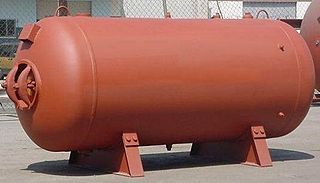
A pressure vessel is a container designed to hold gases or liquids at a pressure substantially different from the ambient pressure.
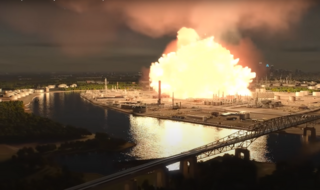
A boiling liquid expanding vapor explosion is an explosion caused by the rupture of a vessel containing a pressurized liquid that is or has reached a temperature sufficiently higher than its boiling point at atmospheric pressure. Because the boiling point of a liquid rises with pressure, the contents of the pressurized vessel can remain a liquid as long as the vessel is intact. If the vessel's integrity is compromised, the loss of pressure drops the boiling point, which can cause the liquid to convert to gas expanding rapidly. BLEVEs are manifestations of explosive boiling.
Cryogenic fuels are fuels that require storage at extremely low temperatures in order to maintain them in a liquid state. These fuels are used in machinery that operates in space where ordinary fuel cannot be used, due to the very low temperatures often encountered in space, and the absence of an environment that supports combustion. Cryogenic fuels most often constitute liquefied gases such as liquid hydrogen.

Liquefied natural gas (LNG) is natural gas (predominantly methane, CH4, with some mixture of ethane, C2H6) that has been cooled down to liquid form for ease and safety of non-pressurized storage or transport. It takes up about 1/600th the volume of natural gas in the gaseous state at standard conditions for temperature and pressure.

A gas cylinder is a pressure vessel for storage and containment of gases at above atmospheric pressure. High-pressure gas cylinders are also called bottles. Inside the cylinder the stored contents may be in a state of compressed gas, vapor over liquid, supercritical fluid, or dissolved in a substrate material, depending on the physical characteristics of the contents. A typical gas cylinder design is elongated, standing upright on a flattened bottom end, with the valve and fitting at the top for connecting to the receiving apparatus.

Liquefaction of gases is physical conversion of a gas into a liquid state (condensation). The liquefaction of gases is a complicated process that uses various compressions and expansions to achieve high pressures and very low temperatures, using, for example, turboexpanders.

Industrial gases are the gaseous materials that are manufactured for use in industry. The principal gases provided are nitrogen, oxygen, carbon dioxide, argon, hydrogen, helium and acetylene, although many other gases and mixtures are also available in gas cylinders. The industry producing these gases is also known as industrial gas, which is seen as also encompassing the supply of equipment and technology to produce and use the gases. Their production is a part of the wider chemical Industry.
Liquefied gas is a gas that has been turned into a liquid by cooling or compressing it. Examples of liquefied gases include liquid air, liquefied natural gas, and liquefied petroleum gas.
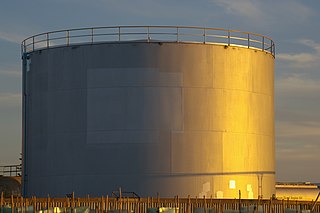
Storage tanks are containers that hold liquids or compressed gases. The term can be used for reservoirs, and for manufactured containers. The usage of the word "tank" for reservoirs is uncommon in American English but is moderately common in British English. In other countries, the term tends to refer only to artificial containers. In the U.S., storage tanks operate under no pressure, distinguishing them from pressure vessels.
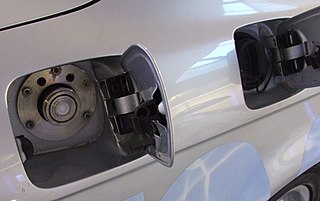
A bivalent engine is an engine that can use two different types of fuel. Examples are petroleum/CNG and petroleum/LPG engines, which are widely available in the European passenger vehicle aftermarket.
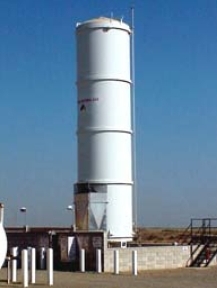
A liquefied natural gas storage tank or LNG storage tank is a specialized type of storage tank used for the storage of Liquefied Natural Gas. LNG storage tanks can be found in ground, above ground or in LNG carriers. The common characteristic of LNG Storage tanks is the ability to store LNG at the very low temperature of -162 °C (-260 °F). LNG storage tanks have double containers, where the inner contains LNG and the outer container contains insulation materials. The most common tank type is the full containment tank. Tanks vary greatly in size, depending on usage.

An LNG carrier is a tank ship designed for transporting liquefied natural gas (LNG).
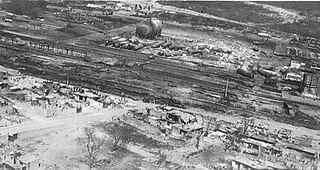
The San Juanico disaster involved a series of fires and explosions at a liquefied petroleum gas (LPG) tank farm in the settlement of San Juan Ixhuatepec, municipality of Tlalnepantla de Baz, State of Mexico, Mexico on 19 November 1984. The facility and the settlement, part of Greater Mexico City, were devastated, with 500–600 victims killed, and 5000–7000 suffering severe burns. It is one of the deadliest industrial disasters in world history, and the deadliest industrial accident involving fires and/or explosions from hazardous materials in a process or storage plant since the Oppau explosion in 1921.
A liquid nitrogen engine is powered by liquid nitrogen, which is stored in a tank. Traditional nitrogen engine designs work by heating the liquid nitrogen in a heat exchanger, extracting heat from the ambient air and using the resulting pressurized gas to operate a piston or rotary motor. Vehicles propelled by liquid nitrogen have been demonstrated, but are not used commercially. One such vehicle, Liquid Air, was demonstrated in 1902.
The Feyzin disaster occurred in a refinery near the town of Feyzin, 10 kilometres south of Lyon, France, on 4 January 1966. An LPG spill occurred when an operator was draining water from a 1,200m³ pressurised propane tank. The resultant cloud of propane vapour spread, until it was ignited by a car on an adjoining road. The pool of propane in the bund caused the storage tank to be engulfed in flames, which produced a Boiling Liquid Expanding Vapour Explosion (BLEVE) when the tank ruptured. This resulted in a fireball which killed and injured firemen and spectators. Flying missiles broke the legs of an adjacent sphere which later BLEVE'd. Three further spheres toppled due to the collapse of support legs which were not adequately fire protected. These vessels ruptured but did not explode. A number of petrol and crude oil tanks also caught fire. The conflagration took 48 hours to bring under control. This incident resulted in the deaths of 18 people, the injury of 81 and extensive damage to the site.

A gas carrier, gas tanker, LPG carrier, or LPG tanker is a ship designed to transport LPG, LNG, CNG, or liquefied chemical gases in bulk.

A liquefied natural gas terminal is a facility for managing the import and/or export of liquefied natural gas (LNG). It comprises equipment for loading and unloading of LNG cargo to/from ocean-going tankers, for transfer across the site, liquefaction, re-gasification, processing, storage, pumping, compression, and metering of LNG. LNG as a liquid is the most efficient way to transport natural gas over long distances, usually by sea.

A marine LNG engine is a dual fuel engine that uses natural gas and bunker fuel to convert chemical energy in to mechanical energy. Due to natural gas' cleaner burning properties, the use of natural gas in merchant ship propulsion plants is becoming an option for companies in order to comply with IMO and MARPOL environmental regulations. The natural gas is stored in liquid state (LNG) and the boil-off gas is routed to and burned in dual fuel engines. Shipping companies have been cautious when choosing a propulsion system for their fleets. The steam turbine system has been the main choice as the prime mover on LNG carriers over the last several decades. The decades-old system on steam propelled LNG carriers uses BOG. LNG carriers are heavily insulated to keep the LNG at around -160 °C – to keep it liquefied. Despite insulation, the LNG containment area is penetrated by heat which allows for naturally generated boil-off gas (BOG).
Gaztransport & Technigaz SA is a French multinational naval engineering company with headquarters in Saint-Rémy-lès-Chevreuse, France.















